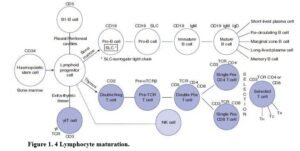Haemopoietic stem
cells (HSCs) differentiate into myeloid and lymphoid progenitor cells. Lymphoid-committed precursor cells mature in
♦Bone marrow – where they receive signals that promote development into B cells or
♦Thymus – where T cells develop.
A small proportion of T cells, especially non-conventional ones like γδ T cells and NK-T cells may mature outside the thymus.
Lymphocytes mature by a series of sequential differentiation steps defined by patterns of molecular expression, especially antigen receptor or antigen receptor-associated molecules. The early phases of lymphocyte maturation occur independent of exposure to antigen. Once complete antigen receptors are expressed by developing lymphocytes, further survival and functional capacity requires interaction with antigen (Figure 1.4).

B lymphocyte maturation B cells are generated throughout life in the bone marrow. Development stages are marked by the ordered rearrangement of immunoglobulin genes. The key stages and the important molecule expression patterns are highlighted.
♦Pro-B cells – express B cell-specific molecules (CD 19, surrogate light chain). Immunoglobulin genes are in germline configuration.
♦Pre-B cells – express surface IgM heavy chain associated with surrogate light chain – pre-B receptor. Immunoglobulin genes are rearranged by enzymes encoded by Recombinase Activating Genes (RAG), and the IgM expressed originates from whichever chromosome successfully rearranged first. RAG gene expression is switched off, inhibiting rearrangement of immunoglobulin heavy chain genes on the other chromosome – allelic exclusion. Subsequent re-expression of RAG allows light chain immunoglobulin genes to rearrange. Kappa (K) genes initially rearrange. If unsuccessful, the λ genes rearrange sequentially until a functional light chain is produced.
♦Immature B cells – IgM+ IgD— immunoglobulin receptor expression allows these cells interact specifically with antigen. Further survival and differentiation is dependent on whether or not selection or activation signals are received through the BCR.
T lymphocyte maturation T cells develop from thymic lymphoid progenitor cells. NK cells and NK-T cells also arise from thymic progenitors, but details of their development are unclear. As with B cells, stages of T cell maturation are marked by specific patterns of TCR and other molecule expression. The key stages are
♦‘Double-negative’ cells – lack CD4 and CD8 expression. Most have not rearranged TCR gene segments. CD2 but not CD3 is expressed.
♦‘Double positive’ cells – dually express CD4 and CD8. T cells only reach this stage if a successful TCR is made.
- Selected T cells – at this stage T cells are screened for ability to interact with host MHC – peptide complexes expressed on cortical epithelial cells and interdigitating dendritic They also lose either CD4 or CD8 and become ‘single positive’ thymocytes. T cells must be able to recognise MHC for conventional T cell-mediated antigen recognition. Cells that pass this hurdle are positively selected for survival. T cells then undergo negative selection, where potentially autoreactive T cells are eliminated, an important safeguard against autoimmunity.
Negative selection in T cells is more rigorous than with B cells. A lack of T cell help will hold autoreactive B cells in check. Only about 1% of thymocytes mature and enter the peripheral pool.
Both αβ- and γδ-T cells are derived from the same early thymocyte precursor cell type. The type of TCR expressed – either TCR^ or TCRyS – depends on which of the TCR chains makes the first successful rearrangement. The same T cell cannot express both types of TCR. Successful rearrangement of TCRa disables δ-gene segments, and β and δ chains do not usually align correctly to form a functional TCR. Early in life, more T cells of the TCRγδ lineage are produced, but subsequently TCRαβ-expressing T cells predominate. TCRγδ cells often do not express either CD4 or CD8.




